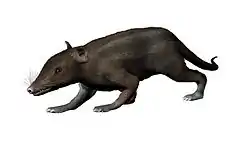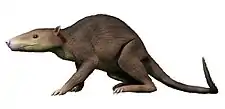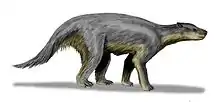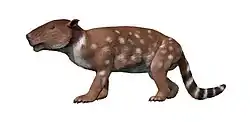Maelestes
Maelestes is a prehistoric shrew-like mammal discovered in 1997 in the Gobi Desert. The animal lived in the late Cretaceous Period, around 71-75 million years ago, and was a contemporary of dinosaurs such as Velociraptor and Oviraptor. According to some scientists, the discovery and analysis of this species suggests that true placental mammals appeared near the time the non-avian dinosaurs became extinct 66 million years ago, not much earlier in the Cretaceous as thought by others.[1] However, the presence of an epipubic bone, among other characteristics, place it as a non-placental eutherian.[1][2]
| Maelestes Temporal range: Late Cretaceous | |
|---|---|
| Scientific classification | |
| Kingdom: | |
| Phylum: | |
| Class: | |
| Order: | |
| Family: | |
| Genus: | Maelestes Wible et al., 2007 |
| Species: | M. gobiensis |
| Binomial name | |
| Maelestes gobiensis Wible et al., 2007 | |
Reproduction
Although Maelestes was a eutherian, it was not a placental mammal. The presence of an epipubic bone suggests that it could not expand its torso the same way placentals can, forcing it to give birth to small, relatively undeveloped young like modern marsupials. Like modern marsupials, it might have had a pouch, though there is no evidence for this and many marsupials like shrew opossums lack pouches.
References
- Wible, J.R., G.W. Rougier, M.J. Novacek, and R.J. Asher. (2007). "Cretaceous eutherians and Laurasian origin for placental mammals near the K/T boundary." Nature, 447: 1003-1006.
- Giallombardo, Andres, 2009 New Cretaceous mammals from Mongolia and the early diversification of Eutheria Ph.D. dissertion, Columbia University, 2009402 pages; AAT 3373736 (abstract) The origin of Placental Mammals, Cimolestidae, Zalambdalestidae
External links
- Dinos' demise spurred rise of the mammals, new fossil suggests, Yahoo! News
- Mammals burst on the scene after dinosaurs' exit, Yahoo! News
- Placental Mammals Originated On Earth 65 Million Years Ago, Researchers Assert by the Carnegie Museum of Natural History.




